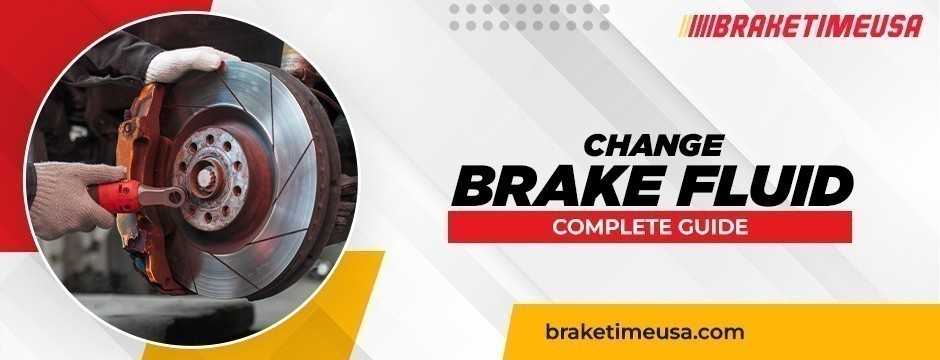Your cart is empty
Subtotal:$0.00
Brake fluid, often overshadowed by more glamorous aspects of vehicle maintenance, is a silent guardian that plays a pivotal role in your vehicle's safety and performance. Its maintenance can often be overlooked until it's too late, leading to brake system failures and compromised safety. In this comprehensive guide, we delve into the world of brake fluid to answer a crucial question: how often should you change your brake fluid? We'll explore the significance of brake fluid, indicators that it's time for a change, the process of changing it, and the best practices to maintain a safe and efficient braking system. Let's embark on this journey to uncover the vital role that brake fluid plays in your vehicle's operation.
 Deciphering the Role of Brake Fluid
Deciphering the Role of Brake Fluid
Brake fluid is the unsung hero of your vehicle's braking system. This often underappreciated fluid serves several indispensable functions, making it a critical component for the safety and performance of your vehicle. Here's why brake fluid should never be underestimated:
Imagine pressing your brake pedal, and your vehicle doesn't respond. This could be a nightmare scenario if it weren't for brake fluid and Brake Kits. When you apply pressure to the brake pedal, it generates hydraulic pressure within the brake lines. This pressure is then transmitted through the brake fluid, activating the Brake Kits, which in turn causes the brake calipers or wheel cylinders to squeeze the brake pads or shoes against the rotors or drums. This hydraulic transmission is the magic behind your vehicle's ability to stop when you need it to.
The braking process generates an incredible amount of heat. Think about the energy dissipated when your car decelerates from highway speeds. Brake fluid plays a crucial role in dissipating this heat, preventing the brakes from overheating and losing their effectiveness. High-quality brake fluid can withstand the elevated temperatures produced during braking, ensuring consistent performance.
Beyond its hydraulic properties and heat resistance, brake fluid also acts as a corrosion inhibitor. It plays a vital role in protecting various components of the braking system, such as the brake lines, master cylinder, and calipers, from rust and corrosion. This protection ensures that these components remain in good working condition, maintaining the overall health of the brake system.
Brake fluid, like many other automotive fluids, isn't immune to degradation over time. Factors such as exposure to moisture and temperature fluctuations can gradually compromise its effectiveness. Here are some telltale signs that should prompt you to consider changing your brake fluid:
One of the most noticeable signs that your brake fluid may be deteriorating is a decrease in braking performance. If you find that your brakes feel less responsive or require more effort to bring your vehicle to a stop, it's a strong indicator of a brake fluid issue. Typically, reduced braking performance is due to the presence of air bubbles or moisture in the brake lines, which interfere with the hydraulic transmission of force from the brake pedal to the wheels.
A spongy or mushy brake pedal can be another clear indication of air or moisture in the brake fluid. When the brake fluid is no longer in its optimal condition, it can't transmit hydraulic pressure effectively, resulting in a less firm pedal feel. A spongy brake pedal is not only uncomfortable but also compromises your ability to modulate braking force accurately.
Brake fluid is typically a clear or pale yellow color when new. However, as it ages and becomes contaminated, it can take on a dark brown or black hue. The presence of discolored brake fluid is a clear sign that it's contaminated and no longer capable of providing the necessary protection to your braking system. Discoloration is often accompanied by a reduction in the fluid's performance.
Squealing, squeaking, or grinding noises when you apply the brakes can indicate various issues within the braking system. While these sounds can sometimes be attributed to worn brake pads or other factors, contaminated brake fluid can also contribute to unusual noises during braking. It's essential to investigate the cause of these noises promptly to ensure your vehicle's safety.
Some modern vehicles are equipped with brake fluid level sensors that trigger a warning light on the dashboard when the fluid level is low. If you notice this warning light illuminated, it's crucial to check your brake fluid level and quality promptly. Ignoring this warning can lead to potentially dangerous situations on the road.
The frequency at which you should change your brake fluid depends on several factors, including the type of brake fluid used and your driving habits.
Here's a general guideline to help you determine how often to change brake fluid: Every Two Years
As a rule of thumb when it comes about how often to replace brake fluid, most experts recommend changing your brake fluid every two years. This interval helps ensure that your brake fluid remains in good condition and can effectively transmit hydraulic pressure. However, it's essential to note that this timeframe can vary based on the type of brake fluid you use and the manufacturer's recommendations for your specific vehicle. To get precise guidance, consult your vehicle's manual or seek advice from a trusted mechanic.
If you're the proud owner of a high-performance or sports car, your brake fluid change schedule may differ from the standard two-year interval. The intense braking and high temperatures associated with performance driving can cause the brake fluid to degrade more rapidly. In such cases, it's advisable to change the brake fluid annually to ensure optimal braking performance and safety.
For those who regularly navigate severe driving conditions, such as stop-and-go traffic, mountainous terrain, or extreme heat, your brake fluid may deteriorate at a faster rate. In these situations, consider more frequent brake fluid changes to ensure that your braking system can consistently deliver the stopping power you need.
Changing your brake fluid is a task that can be accomplished by a competent DIY enthusiast or entrusted to a professional mechanic. Here's a general overview of the process for how to change brake fluid:
Before you begin, gather the essential tools and materials required for the job. These include a jack and jack stands, a brake bleeder kit, a turkey baster or syringe, a wrench or socket set, a clear plastic hose, and a container for collecting the old brake fluid.
Each brake caliper or wheel cylinder on your vehicle has a bleeder valve that allows you to release the old brake fluid. Before you start the actual process, locate these valves on each wheel where you plan to change the brake fluid.
Use a jack and jack stands to lift your vehicle off the ground securely and safely. Ensure that the vehicle is stable and won't shift during the process.
With the vehicle lifted and secured, attach the clear plastic hose to the bleeder valve on one of the wheels. Place the other end of the hose into the collection container. Using a wrench or socket set, open the bleeder valve, allowing the old brake fluid to flow into the container.
Once you've drained the old brake fluid, it's time to replenish the system with fresh brake fluid. Start by removing any remaining old fluid from the master cylinder reservoir. Refill the reservoir with fresh brake fluid, ensuring you use the recommended type for your vehicle.
Bleeding the brakes is a crucial step in removing any air or old fluid from the brake lines. It ensures that the entire system is filled with fresh brake fluid. Start with the wheel farthest from the master cylinder, which is typically the rear passenger side. Enlist the help of a friend or family member to assist with this process. Have them press the brake pedal while you open and close the bleeder valve. Repeat this step for each wheel in the recommended order until the fluid runs clear.
After bleeding the brakes, it's essential to test them to ensure they feel firm and responsive. Pump the brake pedal a few times to build pressure, and then apply the brakes to check for any unusual noises or pedal sponginess. This step helps confirm that your brake system is functioning correctly.
It's crucial to dispose of the old brake fluid responsibly and in accordance with local regulations. Many auto parts stores accept used brake fluid for recycling. Avoid pouring it down drains or disposing of it in an environmentally harmful manner.
In addition to changing your brake fluid at the recommended intervals, here are some best practices for maintaining a healthy brake system:
Periodically inspect the brake fluid level in the master cylinder reservoir. If it's below the minimum level, it could indicate a leak or excessive brake pad wear. Addressing these issues promptly can prevent further damage to your braking system.
Stick to the type of brake fluid recommended by your vehicle manufacturer. Mixing different types of brake fluid can lead to brake system damage and reduced performance.
If you notice any brake fluid leaks, whether from the brake lines, master cylinder, or calipers, address them immediately. Brake fluid leaks can lead to a loss of brake pressure and compromised braking performance.
If you experience any of the signs mentioned earlier, such as a spongy brake pedal or decreased braking performance, consider bleeding the brakes to remove air or moisture from the brake lines. This maintenance step can help restore optimal brake system function.
Brake fluid is a critical yet often overlooked component of your vehicle's braking system. It's the hydraulic lifeline that ensures your ability to stop safely on the road. Neglecting your brake fluid can lead to decreased braking performance, safety concerns, and costly repairs. By understanding the importance of brake fluid, recognizing the signs that it's time for a change, and following best practices for maintenance, you can enjoy a reliable and efficient braking system. Remember, your safety on the road hinges on the health of your brake fluid – don't underestimate its significance.
To find out more, visit us at ! Mar 27, 2024Unlocking the Benefits of Drilled and Slotted Rotors
Mar 27, 2024Unlocking the Benefits of Drilled and Slotted Rotors Mar 22, 2024Choosing The Right Brake Pad Kits For Your Vehicle: A Comprehensive Buyer's Guide
Mar 22, 2024Choosing The Right Brake Pad Kits For Your Vehicle: A Comprehensive Buyer's Guide Mar 18, 2024Exploring Different Types of Rear Brake Rotors
Mar 18, 2024Exploring Different Types of Rear Brake Rotors Mar 6, 2024Comparing Drilled vs. Slotted Disc Brake Rotors: Which Is Right for You?
Mar 6, 2024Comparing Drilled vs. Slotted Disc Brake Rotors: Which Is Right for You?
 Feb 5, 2024Comprehensive Guide on How To Check Brake Pads and Rotors for Optimal Maintenance
Feb 5, 2024Comprehensive Guide on How To Check Brake Pads and Rotors for Optimal Maintenance© 2023 - 2024 Braketimeusa. All rights reserved.
